A talk with Gordon Thomas, an investigative journalist who explains in his new book how the Vatican saved thousands of Jews during WWII.
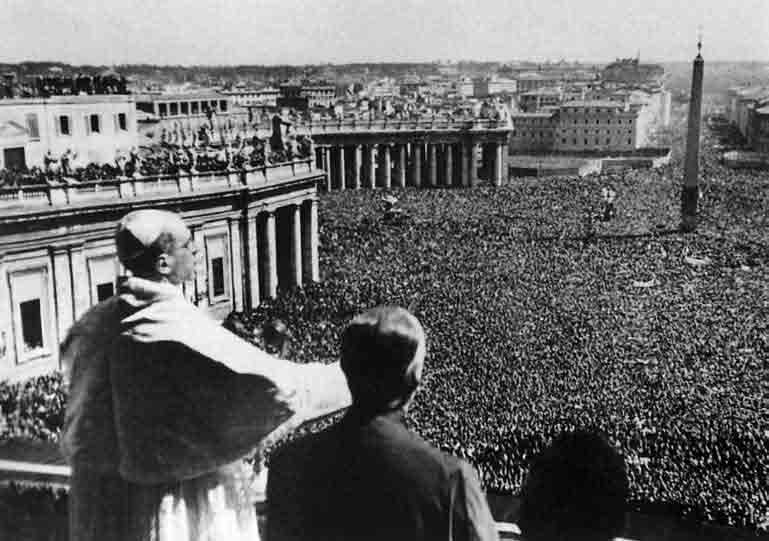
Pope Pius XII addresses a postwar crowd in St. Peter’s Square.
Seventy years ago this October, in the fall of 1943, Rome’s close-knit Jewish community underwent its most agonizing trial. In the early morning hours of October 16, 1943, during the German occupation of Rome, Nazi troops descended upon Rome’s Jews, estimated to be at least 8,000. The intent, following orders from Berlin, was to seize and deport all of them.
What happened that day—and what Pope Pius XII’s role was in its harrowing events—has been written about, and debated, for decades. But not until now, thanks to an extraordinary new book, have we understood what really occurred, and the full extent of the Pope’s activities.
In The Pope’s Jews: The Vatican’s Secret Plan to Save Jews from the Nazis, author Gordon Thomas explores the controversy in depth, revealing dramatic new details, and concludes with high praise for Pius XII. That Thomas reached such a conclusion after years of research is of no small significance.
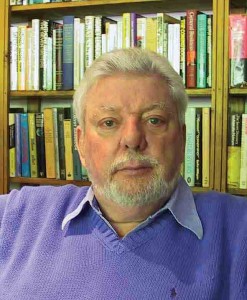
Gordon Thomas.
Gordon Thomas is no ordinary writer: he is one of the most prominent political and investigative journalists of our time, winner of several prestigious writing awards (for details on his accomplishments, visit his website: gordonthomas-author.com). Best known for Gideon’s Spies, the leading work on the Israeli intelligence services, he has authored over 50 books, published in more than 30 countries and in dozens of languages; sales of his works exceed 45 million. Four of his books have been made into feature films, and others have been made into documentaries, or soon will be. Thomas’ stature and success make it clear he could have written about any topic he wanted, but he chose this one for his latest project. Why?
In an exclusive interview with Inside the Vatican, Thomas provided the answer, and explained why he considers The Pope’s Jews “among the most important books I’ve ever written.”
Surprisingly enough—like many events in life—Thomas’ interest came about unexpectedly, from some very prominent men. “When I was researching my book Gideon’s Spies, one of my chief resources was the late Meir Amit, the former chief of Mossad, Israel’s main intelligence agency, who said to me, ‘When you finish this book, what are you going to write about, young man?’ The question was a challenge, because I didn’t know what I would take up next, but Amit led me in a new direction. ‘Let me make a suggestion,’ he said. ‘Why not write about the Jewish community from a different angle, focusing on their ancient community in Rome and their relations with the Catholic Church? I am not a Catholic, but I find the subject fascinating, and if you look into it, you may, too.’”
A short time later, Thomas continued, “I was speaking with an equally famous Israeli officer, Rafi Eitan—who led the team that captured the notorious Nazi war criminal, Adolf Eichmann—and he mentioned to me that he had heard from General Amit that I was interested in writing about Jewish-Catholic relations, and he too encouraged me to pursue the subject, especially because many Israeli intelligence officials have very good relations with the Vatican—something that is not well known, but should be. It was Rafi who brought my attention to a letter Chaim Weizmann, who would become Israel’s first president, wrote in 1943, offering thanks for ‘the support the Holy See was giving to lend its powerful help whenever it can to mitigate the fate of my coreligionists.’”
This led to the discovery of more Jewish praise for Pius, much of it centering on his support for Rome’s Jews. Impressed and moved by these tributes, Thomas’s interest was sparked, even though other commitments emerged which prevented him from immediately pursuing the project. As time passed, however, and Thomas spoke to more Jews and Catholics—several of whom took him on a tour of Rome’s Jewish community—the idea kept coming back to him. “It was pulling at me, and I knew I had to write something.”
What finally compelled him to do so was a study of the recent books about Pope Pius XII, and particularly those assailing his conduct during the Holocaust. “All of the books were missing something,” he says now, “particularly those by Robert Katz (Fatal Silence), Susan Zuccotti (Under his Very Windows) and John Cornwell (Hitler’s Pope). I read them carefully with the growing realization that they began with pre-conceived ideas against Pius XII, and then wrote their books to shape those theories. But when I looked for the proof to back up their claims and criticisms, I couldn’t find it.”
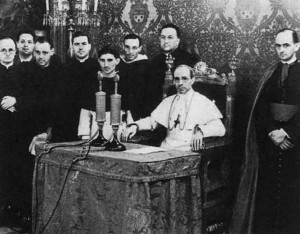
The Pope’s Christmas message, 1942.
Thomas notes that the original cover of Cornwell’s Hitler’s Pope—a blurred image of Nuncio Eugenio Pacelli (the future Pius XII) visiting Germany—deceptively implied that the Pope-to-be had visited Hitler, when in fact, Pacelli never set foot on Nazi soil (he left for good in 1929—four years before Hitler obtained power—to become Cardinal Secretary of State in Rome); furthermore, Pius XII never met Hitler, much less collaborated with him. The two were implacable opponents—one, a great Christian statesmen and Pope; the other, a psychotic and mass-murdering despot. How the two ever became linked is one of the great scandals of history.
Now fully conscious of the campaign against Pius XII, and wanting to get to the truth about that fateful day in October of 1943—and Pius XII’s relationship to Rome’s Jews in general— Thomas, with the help of his wife Edith—an expert researcher fluent in numerous languages—set aside two years to intensely study the topic. Along the way, they were assisted by an international team of experts from Italy, Israel, the United Kingdom and the United States, who provided them with documents and testimony that have remained virtually unknown.
As he learned more and more about Rome’s wartime situation—both from his own talks with survivors or their descendents, and from the flow of information he received almost daily from his research network—Thomas decided to tell the story from three different angles:
—first, from the perspective of Rome’s Jewish community, whose experience was traumatic and life-altering;
—second, from the view of Pius XII and Vatican officials, as they relentlessly thwarted the Nazis and protected persecuted Jews;
—and third, from the Germans themselves, who, though suffused with evil characters, sometimes contained individuals who bravely resisted Hitler, and sought to stop and counteract his deadly measures.
What gives The Pope’s Jews such power is its immediacy. Drawing from his immense research, Thomas re-creates the events leading up to the Nazi round-up of Rome’s Jews, and conveys the emotions and anguish they experienced in unforgettable ways—the knock on the door, the terror, the cries for help, the despair….The one ray of light during the searing ordeal were those who tried to block the round-up and rescue its intended victims. The heroes were many—even though now largely forgotten—but Thomas’s book brilliantly brings then back to life, paying them homage and providing some long-overdue recognition.
Among the rescuers was Dr. Vittorio Sacerdoti, a young Jewish doctor who worked in a Roman hospital staffed by many Catholics. As soon as the Nazi occupation took place, and especially after the round-up, he began taking in desperate Jewish refugees fearing for their lives, creating an imaginary disease called “K Syndrome.” When the Nazis came looking for them, Sacerdoti, along with his Catholic co-workers, announced they were all in confinement, having contracted a contagious, airborne disease. Terrified of catching it, the Germans fled. The ingenious strategy saved the lives of many Jews, and Thomas found survivors who recounted the inspiring story for him.
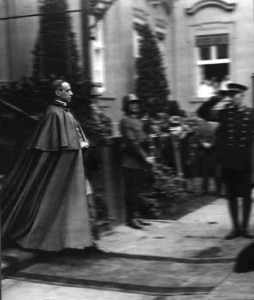
The original cover of Cornwell’s Hitler’s Pope — a blurred image of Nuncio Eugenio Pacelli (the future Pius XII) visiting Germany — deceptively implied that the Pope-to-be had visited Hitler, when in fact, Pacelli never set foot on Nazi soil.
The Pope’s Jews reveals the actions of other rescuers, equally fearless: Monsignor John Patrick Carroll-Abbing, the priest who used his ambulance to rescue Jews; Father Robert Leiber, the Pope’s private secretary; Father Pankratius Pfeiffer, the Pope’s personal liaison with the German high command; Sister Pascalina Lehnert, the Pope’s long-time personal assistant; Father Anton Weber, head of the Pallottine Fathers in Rome; Monsignor Alfredo Ottaviani, head of the Holy Office; and especially Monsignor Hugh O’Flaherty, the legendary Irish member of the Curia, immortalized by Gregory Peck in the film The Scarlet and the Black, whose secret network protected escaped Allied prisoners of war and fleeing Jews.
Behind these rescuers stood a man who has been more misrepresented than any individual from that time—perhaps more than any other individual in human history—Pope Pius XII. According to critics, on the day of the round-up, Pius made only a brief, weak diplomatic inquiry about the Jews, but otherwise remained passive, then receded into the background, allowing the persecution of the Jews to take place “under his very windows.” In fact, however, as Thomas’s book details, the Pope took very decisive action on that day, issuing several forceful protests against the murderous round-up, and throughout the entire occupation intervened again and again for Rome’s Jews. Although the ruthless Nazis were able to deport over 1,000 Jews after the raid, the vast majority of them—over 85%—-survived. They were being hidden and protected in Church-run institutions with Pius XII’s knowledge and support; and the pope even opened up his own summer residence at Castel Gandolfo to take in Jews targeted for death. As the U.S. Holocaust Memorial Museum notes: “For every Jew caught by the Germans in Rome, at least 10 escaped and hid, many in the Vatican.”
Thomas comments: “What people have to understand, and what I try to convey in my book, is that it was Pope Pius XII who is responsible for this extraordinarily high survival rate; it was he who was issuing orders, making impassioned appeals and directing rescuers to protect and save the endangered. Most people, even those sympathetic to Pius, have no idea of how active he was during the German occupation, and how extensive his rescue network really was.”
Thomas underscores the point by highlighting his relationship with O’Flaherty. A number of authors have written books recounting O’Flaherty life-saving deeds, but claim he was acting on his own, without any guidance from the Pope. That is “entirely and demonstrably untrue,” says Thomas, in one of his many groundbreaking revelations. “I have spoken directly with the O’Flaherty family, who also shared private writings of the Monsignor with me, and one thing is abundantly clear: Msgr O’Flaherty was acting on the orders of Pius XII, as he would be the first to emphasize were he living today. It wasn’t he who first created the rescue network; it wasn’t he who set up safe houses for Allied soldiers and Jews; it wasn’t he who sent the food trucks out to feed them—it was the Pope, whom Monsignor O’Flaherty loyally and enthusiastically served.”
What is astonishing about Pius XII’s rescue measures is how much he was able to achieve, even though he was under constant Nazi threats of being kidnapped, deported and even killed himself. Many urged Pius XII to flee, and a lesser man would have done so, but Pius XII remained stolidly at his post in Rome, leading the anti-Nazi resistance.
Thomas’ treatment of the Germans Pius XII faced is riveting, and covers many different personalities—ranging from the diabolical (Hitler and his henchmen), to the evil functionaries in Rome (notably Theodor Dannecker and Herbert Kappler) who carried out Hitler’s orders; to the conflicted German diplomats, like Ernst von Weizsäcker and Albrecht von Kessel, capable of both good and bad; to old-fashioned German officers like Rainer Stahel, the military commander of Rome, who could be prevailed upon to protect Jews; and truly courageous Germans like Joseph Mueller and Colonel General Ludwig Beck, who led the clandestine anti-Nazi resistance against Hitler. Pius XII worked for the good when dealing with them all, which meant fiercely opposing the evildoers, but lending his support and influence to those with a conscience.
Though obviously supportive of the Allied cause, Thomas does not hesitate to question certain American and British leaders, or compare their record toward Jews with Pius XII’s. In 2000, as a result of the U.S. Nazi War Crimes Disclosure Act, the National Archives released 400,000 pages of documents that revealed, among many other facts, two things: how much the Nazis detested the Vatican under Pius XII, precisely because it was protecting Jews; and how the Allies were able to break Germany’s secret codes, allowing them to learn of Nazi plans during the German occupation of Rome.
The question then arises: why, then, didn’t Churchill or FDR warn Rome’s Jews about their impending fate?
Subsequent investigation has shown that neither leader actually received the decoded messages until after the deadly roundup on October 16th; thus they are both cleared. Whether other Allied officials knew more, or could have done something effective, is unknown—there is nothing definitive in the papers released. But Thomas did come upon one jarring note from October of 1943, involving Churchill and his foreign minister:
“Earlier that month the prime minister had discussed at a war cabinet meeting on October 6, whether he should once more denounce all Nazi atrocities. Foreign Minister Anthony Eden had opposed the idea. ‘I am most anxious not to get into the position of breathing fire and slaughter against war criminals and promising condign punishment and a year or two hence having to find pretexts for doing nothing.’”
Thomas compares Eden’s self-serving equivocations with Pius XII, who, far from being inconsistent or unprincipled, “had condemned anti-Semitism, racism, and genocide, before, during, and after the Holocaust.” For doing so, the Nazis branded Pius XII a “mouthpiece of the Jewish war criminals,” whereas “Wild” Bill Donovan, America’s first major intelligence officer and leader of its anti-Nazi espionage unit during the War, “expressed nothing but admiration for him,” says Thomas.
The author knows a great deal about Donovan, since his next book will deal with how the anti-Nazi resistance in Germany and elsewhere helped Jews during World War II. It will complete Thomas’ series of books dealing with the fate of Jews in that historic conflict: Voyage of the Damned (about the tragic S.S. St. Louis refugee ship, which had nearly 1,000 Jews aboard in 1939, trying to escape to America, only to be turned back) was made into a film; Operation Exodus (an equally gripping story about a 1947 refugee ship, carrying 4,700 Jews, trying to get to Palestine but blocked by uncaring officials) was published worldwide; and The Pope’s Jews was pre-sold in seven countries before publication.
Plans are already in the works to develop The Pope’s Jews into a major documentary by Thomas and Chameleon Television, led by Allen Jewhurst, one of the most respected and acclaimed filmmakers in the world.
Until then, Jews and Catholics—and not only they—could do nothing better than learn about this vital chapter in wartime history and interfaith relations than by reading this powerful and invaluable work.

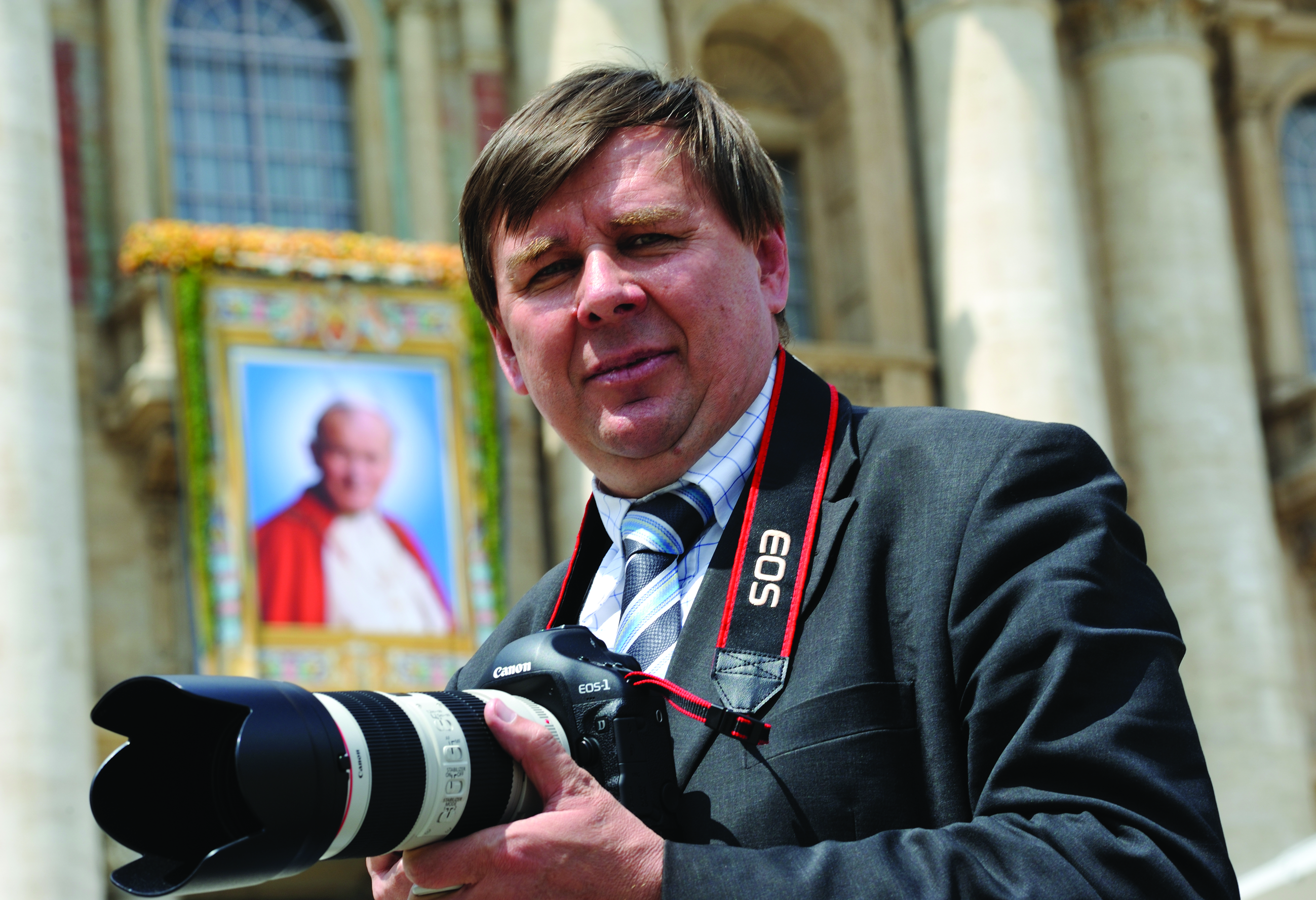
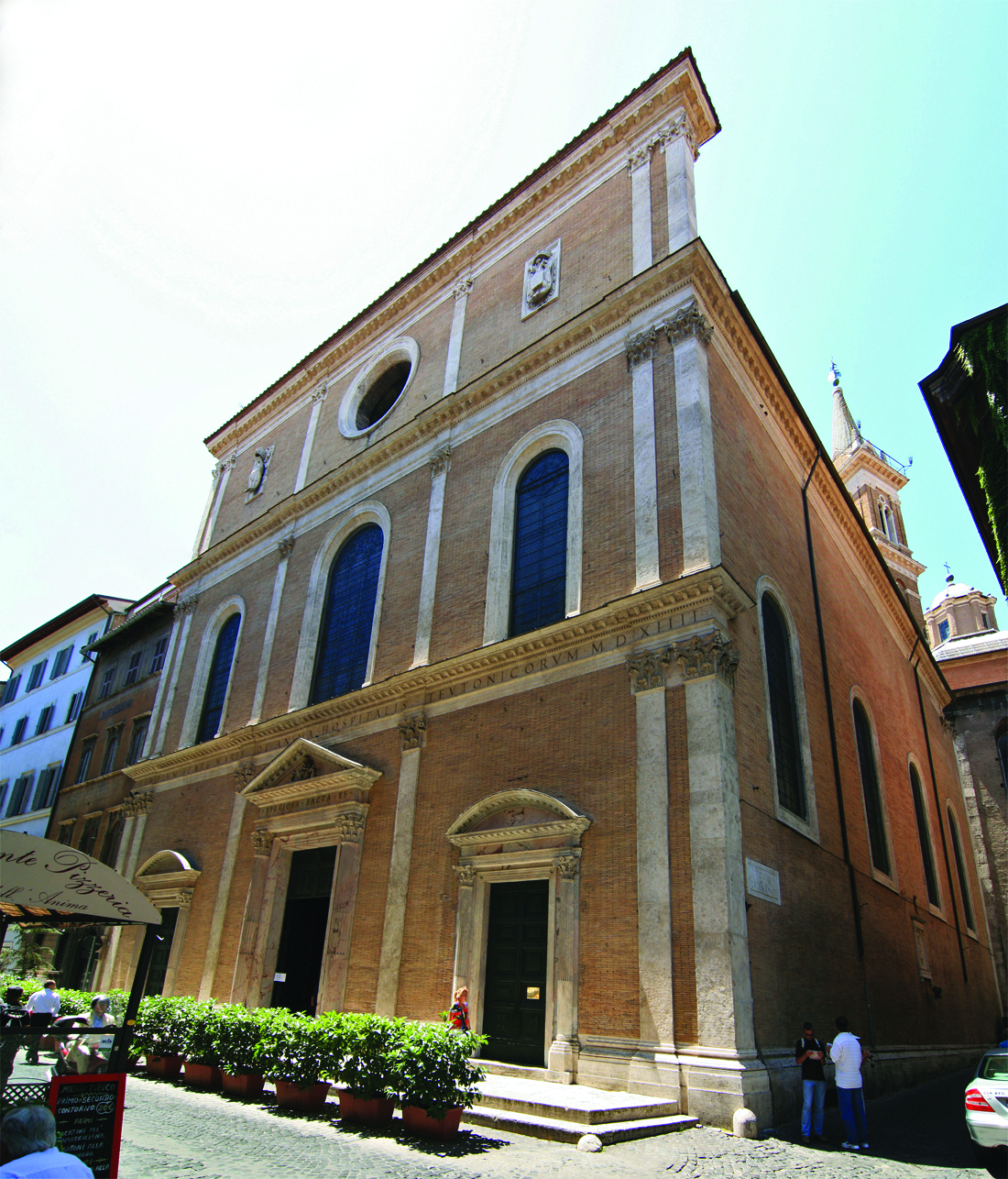
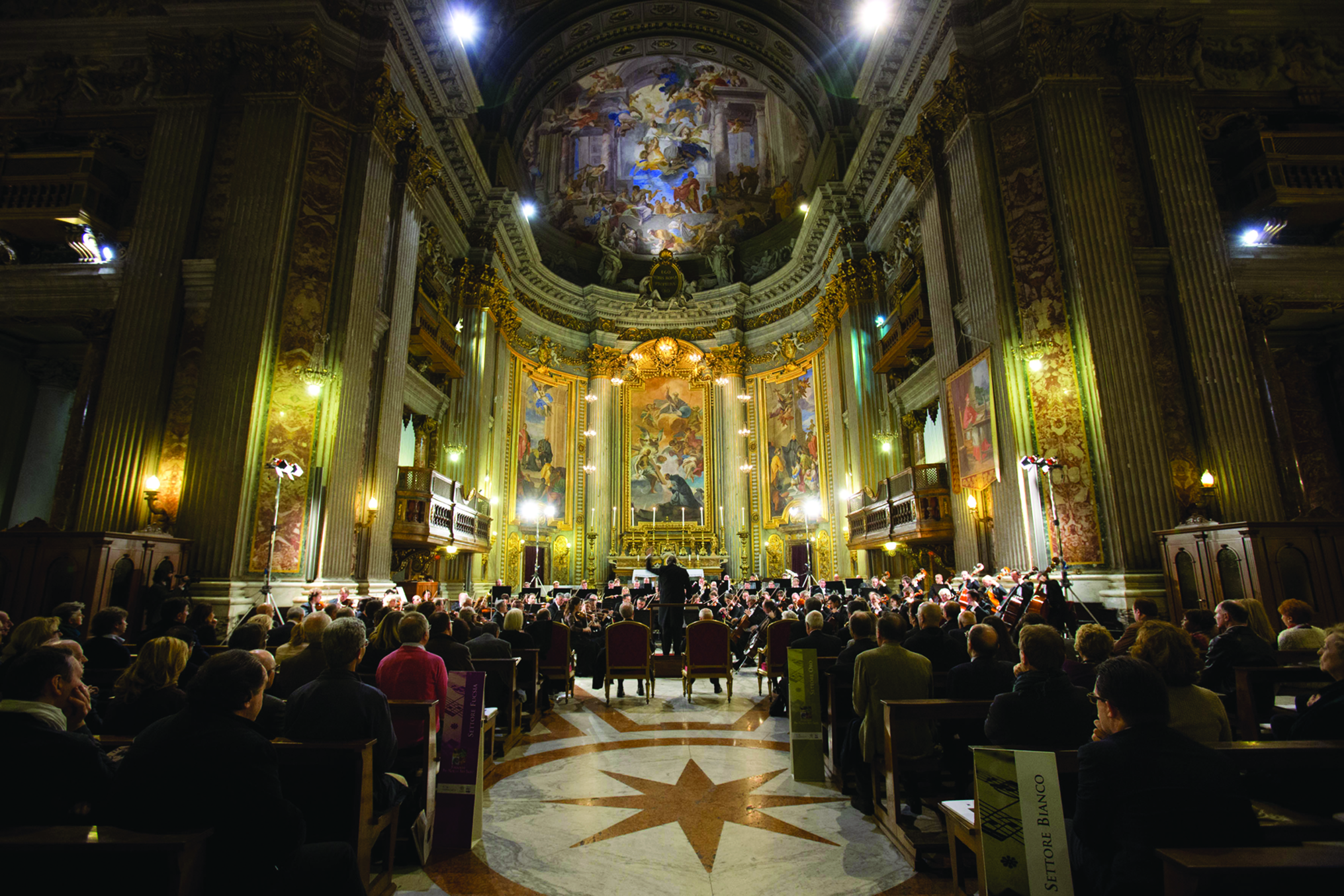
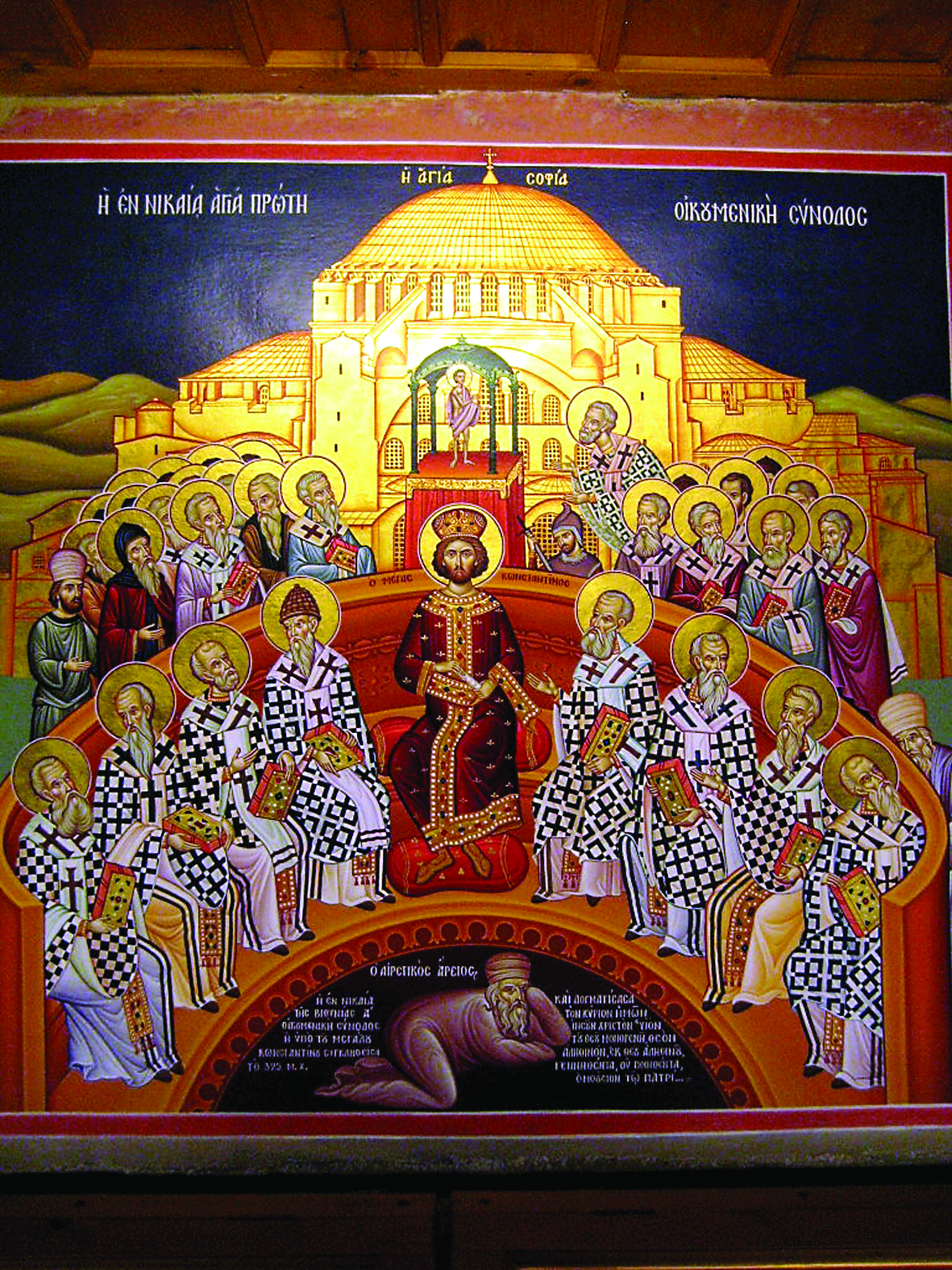
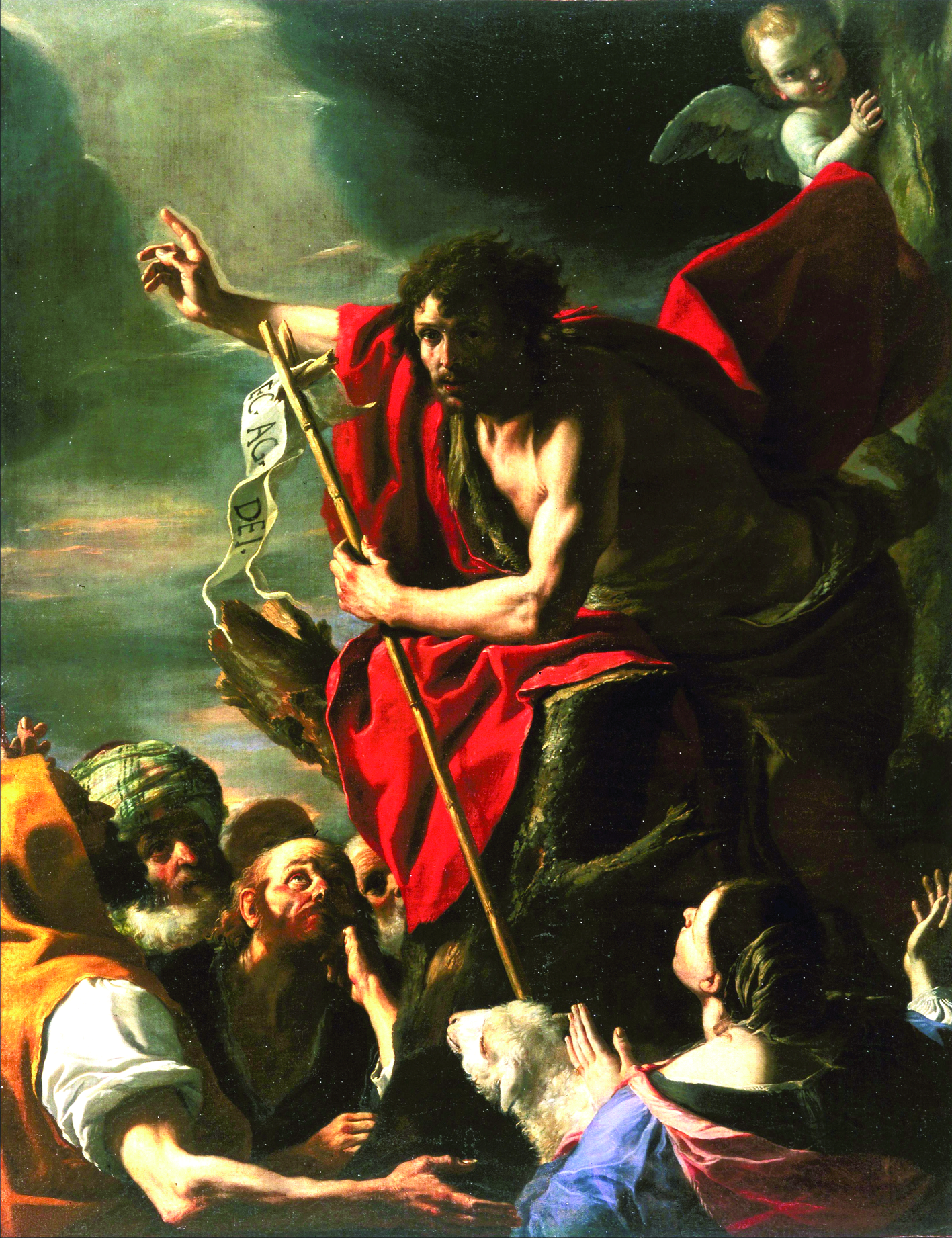
Facebook Comments